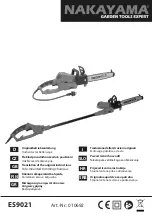
GB
- 24 -
through 90° so that the machine head (4) re-
mains unlocked.
•
Swing up the machine head (4).
•
By loosening the lock screw (12), the machi-
ne head (4) can be angled to the left up to
45°.
•
Check that the voltage marked on the rating
plate is the same as your mains voltage and
connect up the machine.
5.4 Precision adjustment of the stop for 90°
cross-cuts (Fig. 4/5/6/9)
•
Lower the machine head (4) and fix with the
lock pin (16).
•
Slacken the tightening screw (12).
•
Place the stop angle (a) between the saw
blade (5) and the rotary table (8).
•
Slacken the counter nut (23) and adjust the
setting screw (24) until the angle between the
saw blade (5) and the rotary table (8) equals
90°.
•
Re-tighten the counter nut (23) to fix the ma-
chine in this setting.
5.5 Precision adjustment of the stop for 45°
mitre cuts (Fig. 8/9)
•
Lower the machine head (4) and fix with the
lock pin (16).
•
Fix the rotary table (8) in 0° position.
•
Undo the tightening screw (12) and use the
handle (2) to tilt the machine head (4) to the
left until it coincides at 45°.
•
Place the 45° stop angle (a) between the saw
blade (5) and the rotary table (8).
•
Slacken the counter nut (25) and adjust the
setting screw (26) until the angle between the
saw (5) and the rotary table (8) equals exactly
45°.
6. Operation
6.1 90° cross-cuts and 0° rotary table (Fig. 1)
•
To turn the machine on, simultaneously press
the main switch (3) and locking button (30).
•
Important! Place the material you want to saw
flat on the machine surface and secure with
the clamping device (19) so that the mate-
rial cannot move while you are cutting.
•
After switching on the saw, wait for the blade
(5) to reach its maximum speed.
•
Press the release lever (1) sideways and,
using the handle (2), apply steady and light
downward pressure to move the machine
head through the workpiece.
•
When the cut is completed, return the ma-
chine to its top parking position and let go of
the On/Off switch. Caution! A return spring
causes the machine head to rise automati-
cally at the end of the cut. Do not let go of the
handle (2) as soon as the cut is completed
but steady the machine head and allow it to
rise slowly.
6.2 90° cross-cuts and 0°-45° rotary table
(Fig.6)
The crosscut saw can be used to make right and
left angular cuts of 0°- 45° in relation to the stop
rail.
•
Lift the machine head (4) to its top position.
•
Release the rotary table (8) by slackening the
locking handle (10) and pressing the latch
(11).
•
Turn the rotary table (8) by its handle (2) to
the angle you want, i.e. the mark (a) on the
rotary table has to comply with the required
angle dimension (17) on the base plate (9).
•
Re-tighten the locking handle (10) in order to
fix the rotary table (8) in position.
•
Make the cut as described in Section 6.1.
6.3 Mitre cuts 0°-45° and rotary table 0°
(Fig. 4/7)
The crosscut saw can be used to make miter cuts
of 0° - 45° in relation to the work face.
•
Lift the machine head (4) to its top position.
•
Fix the rotary table (8) in 0° position.
•
Undo the tightening screw (12) and use the
handle (2) to tilt the machine head (4) to the
left until the pointer (a) coincides with the re-
quired angle value (15).
•
Re-tighten the locking nut (12) and make the
cut as described in Section 6.1.
Anl_BT_MS_250_L_SPK1.indb 24
Anl_BT_MS_250_L_SPK1.indb 24
30.10.13 10:32
30.10.13 10:32
Содержание BT-MS 250 L
Страница 110: ...110 Anl_BT_MS_250_L_SPK1 indb 110 Anl_BT_MS_250_L_SPK1 indb 110 30 10 13 10 33 30 10 13 10 33...
Страница 111: ...111 Anl_BT_MS_250_L_SPK1 indb 111 Anl_BT_MS_250_L_SPK1 indb 111 30 10 13 10 33 30 10 13 10 33...
Страница 112: ...EH 10 2013 02 Anl_BT_MS_250_L_SPK1 indb 112 Anl_BT_MS_250_L_SPK1 indb 112 30 10 13 10 33 30 10 13 10 33...
















































